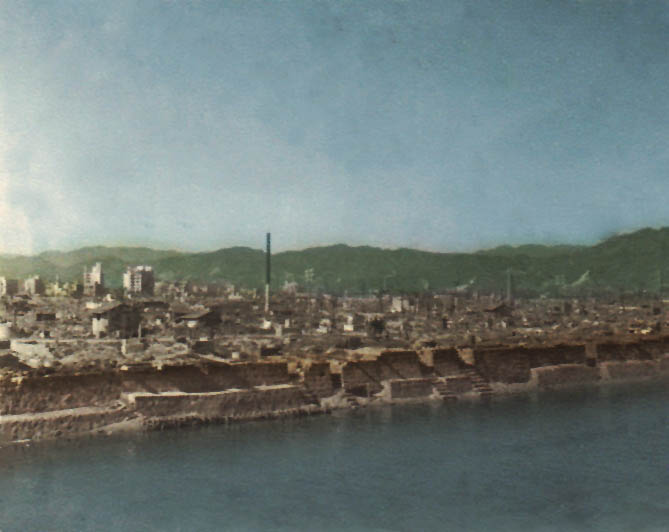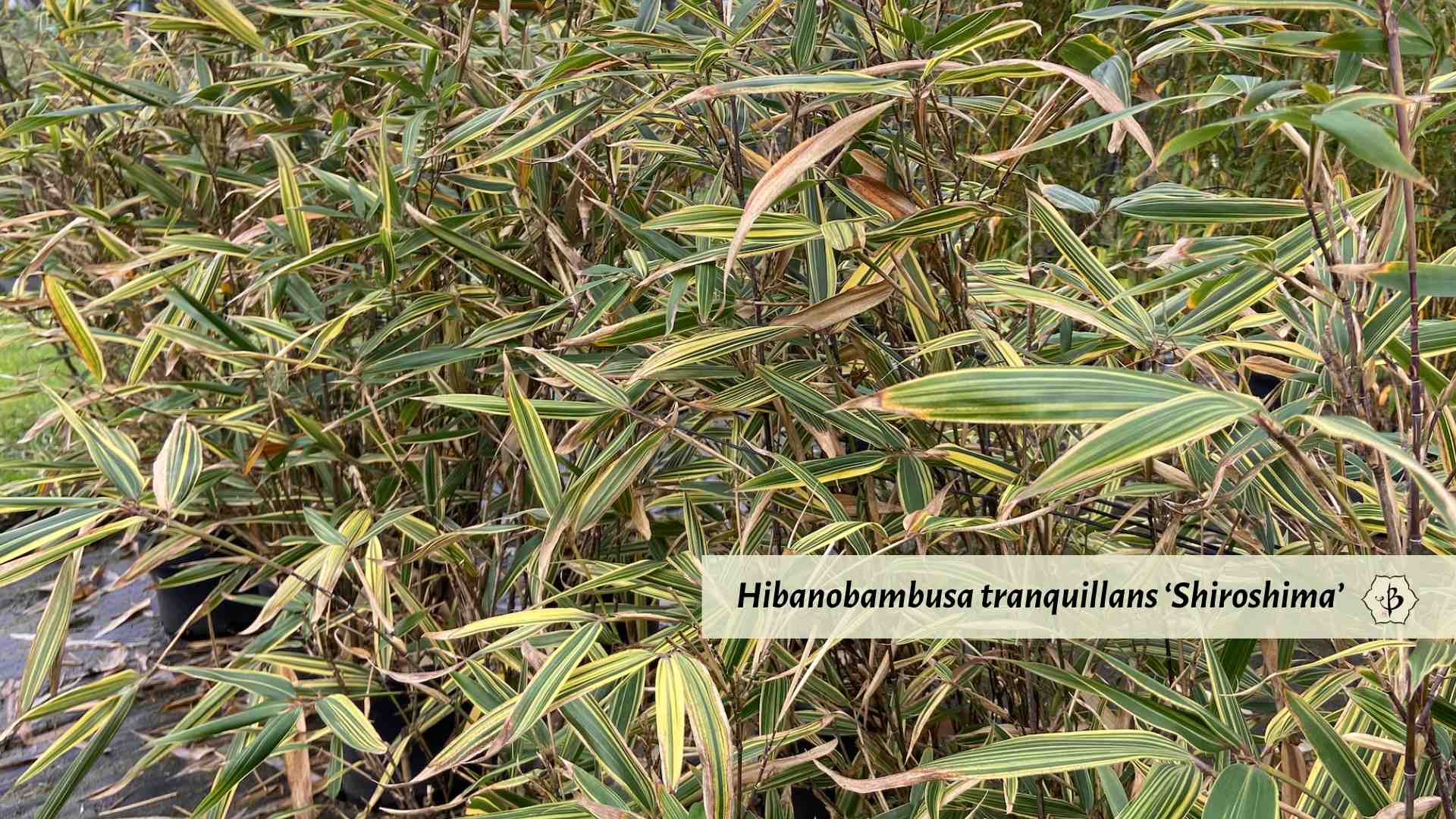If you wander around the internet reading about bamboo — and I’m guessing that you do — you’ll eventually come across a story of how bamboo was one of the only living things to survive after the atomic bombing of Hiroshima in 1945. Other versions tell us that bamboo was the first plant to emerge from the ground as the city slowly came back to life. At this point, it’s not easy to separate fact from fairy tale. And if you’re looking for the “Hiroshima bamboo”, that legendary survivor, the closest species of bamboo you’ll find is probably Hibanobambusa tranquillans ‘Shiroshima’.
Hibanobambusa tranquillans ‘Shiroshima’ is a rare species of bamboo native to Japan. In addition to its beautifully variegated leaves, the compact bamboo variety has a number of desirable characteristics. It grows well in pots, in sun or shade, and can survive sub-zero temperatures as well as droughts. The name of this plant relates to the city of Hiroshima, but it’s uncertain whether it survived the horrific bombing.
This article was first published in February 2022, most recently updated in January 2024. It is part of an ongoing series about different species and cultivars of bamboo. To learn more, check out some of these other detailed articles.
- A gallery of bamboo species
- Bambusa oldhamii: Chinese timber bamboo
- Black Bamboo: Phyllostachys nigra and others
- Blue Bamboo: Species that stand out
- Buddha’s Belly Bamboo
- Chimonobambusa quadrangularis: Square Bamboo
- Dendrocalamus asper: Giant bamboo
- Golden Bamboo: Phyllostachys aurea and others
- Semiarundinaria Fastuosa: Temple Bamboo
The story of Hiroshima bamboo
On August 6, 1945, the US military dropped the first atomic bomb on the city of Hiroshima, Japan. The second fell three days later, over Nagasaki, effectively bringing World War II to an end. More than 350,000 people died in these events, and the cities were laid to waste.
Everything within a 3-kilometer radius was basically vaporized. But gradually, the city was rebuilt, and nature reasserted herself. The legend says that the first plant to sprout up, as Hiroshima recovered, was a bamboo shoot. This story appears frequently on the internet without citation, and it sounds plausible. Bamboo, especially in its underground roots, is incredibly resilient.

To my knowledge, no one has been able to confirm this story. But a recent study, in 2011, determined that at least 170 trees in the city of Hiroshima were more than 66 years old. In other words, they had been there since before the bombing. In Japanese, they refer to such trees as Hibakujumoku. Literally, this translates to “nuked trees”.
A long list of tree species and locations has been created, and among them is bamboo. But they only refer to bamboo generally, never identifying it by species.
Naming and classification of Hibanobambusa tranqillans
As with a lot of rare bamboos, there’s not a universal agreement on the name and classification of this species, Hibanobambusa tranqillans. Other synonyms include Phyllostachys tranquillans and Semiarundinaria tranquillans. Some authors believe it to be a hybrid of Phillostachys nigra ‘Henon’ and Sasa veitchii.
The genus Hibanobambusa is monotypic, meaning that it only contains one species. The name translates to mean “bamboo of Mount Hiba.” Hiba is a mountain in the Hiroshima Prefecture, near the southern end of Honshu, Japan’s largest island.
The subspecies, Shiroshima, is a dwarf variety of the original, and its name reinforces the linguistic connection to the city of Hiroshima.
Characteristics of Hibanobambusa tranqillans ‘Shiroshima’
Apart from the plant’s unusual heritage and the lore associated with World War II, Hibanobambusa tranqillans ‘Shiroshima’ has a variety of appealing traits that make it desirable among bamboo collectors.
There are a whole host of bamboo species with striped leaves, and indeed this is an attractive characteristic. What’s extra special about Hiroshima bamboo is how the leaves are able to retain their shape and luster, even through the dead of winter. Yes, the plant is very suitable for icy winters, cold hardy down to about 5 or 10º below zero F. As an ornamental specimen, it looks fabulous all year long, especially alongside other bamboos of different sizes and colors.

Like other dwarf bamboo varieties, the compact specimen is very complementary to taller, thicker bamboo species, for a sense of contrast. This variety typically grows about 8 to 12 feet tall, with thin culms around 1/2 inch in diameter. It’s a good choice below a canopy of Japanese maple or some type of conifer. Whether you plant it in the sun or the shade, this is a vibrant and versatile bamboo species.
Keep in mind, despite its small stature, this is a running bamboo (as opposed to a clumper). So you’ll want to use some kind of containment strategy to keep it from spreading into other areas of the garden where it doesn’t belong.
Lastly, Hibanobambusa tranqillans ‘Shiroshima’ also grows well in pots, something not every bamboo can tolerate. It even does well indoors, a challenging setting for most bamboos.
Maybe you can’t build a house with Hiroshima bamboo, but as an ornamental, it’s one of the most attractive and versatile cultivars you will find.
The story continues
If you enjoy a good story about bamboo as much as I do, you may want to peruse some of the following links.
- Bamboo in mythology and folklore
- Bamboo in Japanese gardens
- The original bamboo aircraft
- Bamboo and haiku
FEATURE PHOTO: Hibanobambusa tranqillans ‘Shiroshima’ (Jordi Coll Costa)


























Where can I purchase Hiroshima Bamboo ? Have project in NY shady wooded area for client.
Check out the Directory of Bamboo Nurseries.